

How mobility operators can create growth with gamified loyalty programs
How mobility operators can create growth with gamified loyalty programs
In 2023, shared mobility will expand at an incredible rate! But this growth masks the challenges facing mid-size shared mobility operators. While big names dominate, it can be hard to stand out and compete with companies offering rock-bottom prices. So how do you thrive in this market? One answer is gamification. A gamified loyalty program engages new, younger customers, and makes you less vulnerable to price competition.
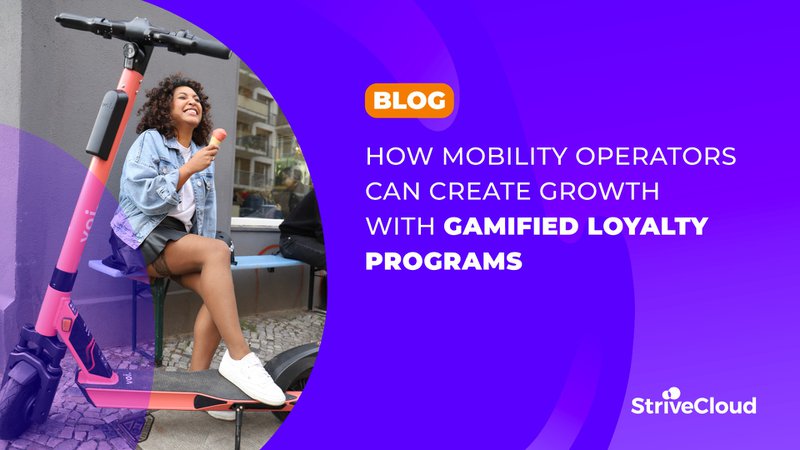
A gamified loyalty program can transform a mobility app, making it more engaging for users. In this article, let’s introduce gamification and showcase some gamification loyalty program examples that have transformed shared mobility apps for the better:
- The trends in shared mobility for 2023 (and where the industry is headed)
- 5 main challenges shared mobility operators face today
- How gamification can help shared mobility operators
- Why a gamified loyalty program is perfect for shared mobility
- How to apply gamification in shared mobility
- Top examples of gamification loyalty programs in shared mobility
- How you can use StriveCloud to add a gamified loyalty program to your mobility app
- FAQs
The trends in shared mobility for 2023 (and where the industry is headed)
One word sums up the state of mobility today: growth! And it’s shared mobility that will experience one of the largest rises. Between 2022 and 2030, the industry will expand at a yearly rate of 16.9%, ballooning from $209 billion to a whopping $731 billion!
This rapid market growth can be attributed to various different factors. Next to the surge in investments, the transportation ecosystem has been growing due to the Government promoting shared mobility solutions to reduce traffic congestion. Additionally, lack of parking spaces, high fuel prices, and high cost of personal vehicle ownership are also key attributes to the market growth.
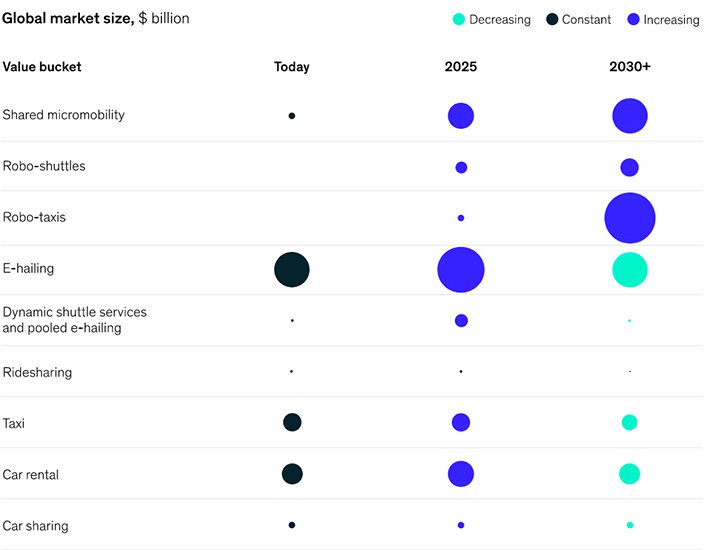
This graph illustrates the projected explosive growth in the shared mobility market through 2030. Despite this optimistic outlook, operators face significant hurdles.
5 main challenges shared mobility operators face today
#1 Competition is tough - especially from big names offering the same for less
Shared mobility is home to a few big names that dominate their own markets. And they do this by offering services that mid-size operators also offer, but at much lower prices. Yet many of these big companies struggled for years, chasing growth and market share at the expense of profitability. Take the e-hailing service Lyft for example. In 2021, they reported their first-ever year of profit after a whole 9 years in business!
Of course, not every shared mobility operator can afford to stay in business for nearly a decade without ever making a penny in profit. As a result, ambitious mid-size operators seeking sustainable growth must compete with big names that have deep pockets, and in turn, a huge competitive advantage.
#2 Lower prices & gamified loyalty programs are huge pull factors
So, competition is tough and big operators can offer lower prices. Unfortunately for mid-size firms, consumers named “competitive price” as the No. 2 most important feature of a shared mobility operator - second only to safety.
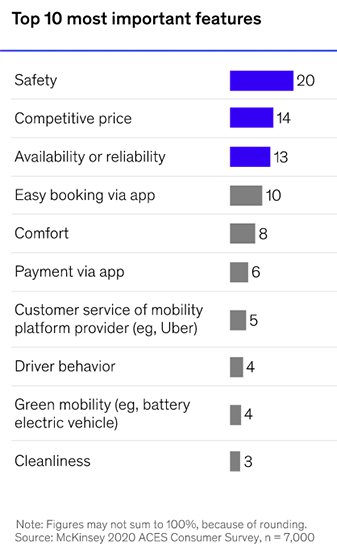
As this chart from McKinsey shows, competitive pricing is a top consideration for consumers, second only to safety. A well-designed loyalty program can effectively enhance price attractiveness without simply cutting costs.
A gamified loyalty program can cheaply enhance your price attractiveness. For a great example, look at how Swedish e-scooter company Voi rewards loyal customers. Under the “ride more, pay less” program, Voi hands out bigger discounts for higher levels. Meaning, the more you use their service, the cheaper it gets!
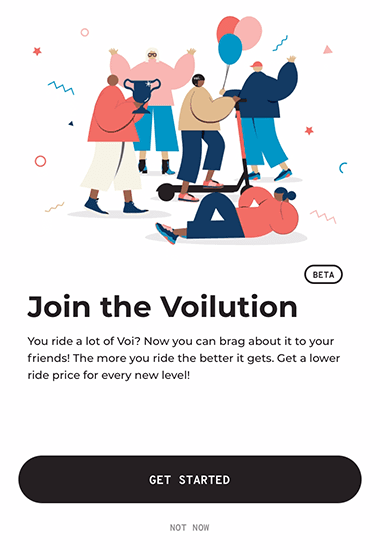
Voi's 'Voialty' program is a prime example of gamification, rewarding users with discounts as they reach higher levels. This kind of program helps operators differentiate their service and stay top-of-mind for customers.
#3 It isn't easy staying top of mind
It can be hard to differentiate your product in shared mobility, and as a consequence, it can also be difficult to stay on the top of consumers’ minds. To the average consumer, the only thing that seems to separate brands is the color of the scooter!
At the end of the day, why should consumers bother learning about your service, when there are so many others competing for that same attention?
#4 Many operators don't know how to keep customers engaged over time
Many mobility operators are overly reliant on traditional marketing tactics such as advertising and promotions rather than focusing on building relationships with their customers. As a result, many apps are clunky, and the user experience is either boring or simply too similar to the alternatives.
#5 Young people ignore marketing acquisition efforts
While younger people are a big potential market for mobility operators, they’re not easy to reach. In fact, experts reckon that 47% of all Millennials and Gen X appear elusive to standard advertising methods. And the story is even worse for Gen Z.
To really reach that audience you need to create an authentic brand personality through fun organic content and storytelling. However, to facilitate that you need to truly understand your audience. By using techniques like social listening you facilitate customer feedback and interaction, which is exactly what Gen Z prefers!
How gamification can help shared mobility operators
Gamification is a great way to encourage your customers to book more rides. How come? Well, it’s easy - a gamified mobility app provides a better experience around renting a scooter or riding a bike! And that’s important when a record 44% of companies today compete mainly over the user experience. That means how your platform engages consumers really makes a difference! And this is where gamification is useful for shared mobility.
What is gamification?
Gamification is the use of game-like elements such as badges, points, and leaderboards in non-game contexts. It’s often used to motivate people to complete certain tasks or reach goals that would otherwise feel boring—for example, a gamified loyalty program or gamified education.
Providing rewards for completing tasks or reaching goals can create a sense of accomplishment and pride in the user's work. Additionally, elements like progress bars or milestones are used as a tool to help users understand their progress.
How does gamification work?
Gamification works by adding elements of game-play to activities that users would normally find mundane. For example, mobility operators might provide levels and badges that customers can unlock as they complete certain actions and reach milestones. Gamification is a great way to keep customers engaged with your platform, but it can also be used to encourage specific behaviors, like booking more trips or referring friends.
Ultimately, gamification is about making activities more fun and rewarding for customers. That happens by using two types of motivation:
Intrinsic motivation is the type of motivation that comes from within an individual and drives them to act without any external reward or pressure. It is based on an individual's internal desires and interests, such as a passion for learning or a desire to achieve something. It has been found to be more effective in achieving long-term goals because it is self-sustaining and does not depend on external rewards or reinforcements.
Extrinsic motivation, on the other hand, is driven by external factors such as rewards, punishments, incentives, and competition. It involves engaging in activities for tangible rewards such as discounts or recognition rather than for the enjoyment of the activity itself. While extrinsic motivation can be effective in achieving short-term goals, it has been found that it often decreases over time due to its reliance on external factors.
Gamification combines both intrinsic and extrinsic motivations in order to create a powerful form of engagement that encourages users to stay active and loyal over the long haul.
How gamification benefits shared mobility operators (and helps overcome the industry’s challenges)
Gamification can help your mobility brand stay top of mind by creating a differentiated experience. By introducing game elements into your mobility app, you create a fun and engaging experience that encourages customers to interact with your brand more often.
Additionally, gamification can help drive acquisition by providing creative incentives for customers to join the platform. Creating a unique narrative with custom challenges, rewards, badges, and level names will make your brand message come to life! This in turn can also help you attract new and younger audiences.
Your integrated storytelling will help to attract new and younger audiences.
Finally, a gamified loyalty program ensures customers remain loyal to your brand and continue using it over time. It can also be used to reward customers for completing certain actions, such as taking a certain number of rides or referring friends to use the service. By tracking user behavior and preferences, you can tailor rewards and incentives to each individual user in order to keep them engaged.
Why a gamified loyalty program is perfect for shared mobility
Shared mobility apps are the perfect fit for a gamified loyalty program. Here’s why! By their very nature, shared mobility apps create and run on vast amounts of data (like duration, distance, and frequency). Well, gamification gets its power from leveraging this data!
For example, imagine a loyalty program where you’re rewarded with an in-app currency based on the distance you’ve covered. Later on, you can redeem that currency for free riding minutes! Additionally, you can earn badges and level up for reaching milestones like 1-5-10-... kilometers.
In this case, a gamified loyalty program incentivizes customers to stick with you. In other words, why would they pick other operators when they still have coins or free-riding minutes left with them?
How to apply gamification in shared mobility
Gamification comes in many forms. Let’s look at some features you can apply to your very own mobility app:
Leveling system (the base of any great gamified loyalty program)
Another way to differentiate your gamified loyalty program is by creating a unique leveling system. Similar to badges, leveling systems provide a sense of achievement within the platform. However, they also serve as an indicator of progress and feedback to the customer.
Points/in-app currencies
Points or in-app currencies are at the heart of every gamified loyalty program. For starters, points incentivize customers to complete certain actions. They also determine the weight and importance of each action.
Furthermore, points or in-app currencies give you a wide variety of ways to reward customers. For instance, you could let exchange coins for free riding minutes, offer discounts, or organize a weekly raffle with shop prizes.
Achievements & badge reward systems
Achievements are a great way to build loyalty since you’re rewarding the customer every time they reach a certain milestone. For example, you can reward customers with a unique badge after their first or tenth trip. These badges serve both as a personal achievement as well as a symbol of social status or recognition within your community!
Top examples of gamification loyalty programs in shared mobility
How EVO Sharing leveraged gamification to get customers to book more trips
Challenge
Achieving growth in such a competitive market can be tough. When the German e-scooter company EVO Sharing came to us, they wanted to achieve 3 main outcomes:
- Boost the number of rides booked per customer. The true sign of a successful platform is when your customers keep coming back for more!
- Attract more students. At the time, EVO Sharing had found great success amongst commuters but was lacking a younger audience.
- Differentiate from competitors. By creating a fun and playful experience.
Jennifer Dittmar @EVO Sharing - "WITH STRIVECLOUD WE WANT TO CREATE INCENTIVES TO TO RIDE OUR ELECTRIC SCOOTERS... WITH THIS THE CUSTOMER SHALL BE MOTIVATED TO USE OUR SERVICE MORE OFTEN."

This dashboard concept shows how gamification elements can be integrated into a mobility app's user interface. Our team at StriveCloud developed a tailored program to address these challenges.
Solution
Our team of gamification experts at StriveCloud created a gamified loyalty program to incentivize desired customer behaviors. For example, now customers can earn EvoCoins for completing a certain amount of miles. Then, they can exchange these coins for free riding minutes.
Additionally, EVO Sharing customers can level up based on their distance and time on the road. This way, they are incentivized to keep coming back for more rides!
Jennifer Dittmar @EVO Sharing - "OUR BUSINESS MODEL IS VERY SUITABLE FOR GAMIFICATION. RECEIVING REWARDS BASED ON DISTANCE, KILOMETERS OR MINUTES DRIVEN MAKES A LOT OF SENSE TO US AND GOES WELL TOGETHER."
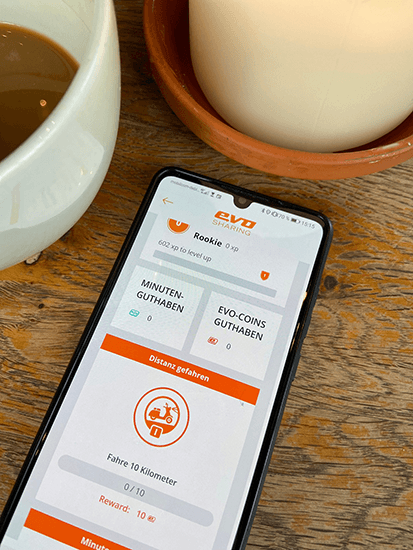
Achievements and badges, like these designed for EVO Sharing, provide users with a tangible sense of accomplishment and progress within the app.
Stuck on how to boost rides per customer? Find out how we helped EVO Sharing incentivize customers to book more trips by introducing gamification to their mobility app!
How we helped HumanForest make London’s mobility greener
Challenge
HumanForest wanted to help London save as much CO2 as possible, by promoting its shared e-bike service in a fun and playful way!
Solution
We created a gamified loyalty program that embodies HumanForest’s brand narrative. Every mile you complete represents one tree worth of CO2 saved. For every five trees or miles, you get one TreeCoin. Based on those metrics you can level up, get featured on the CO2 leaderboard, and more!
Michael Stewart @Human Forest - "WE LOOKED AT MANY LOYALTY SYSTEMS, BUT WE WANTED TO DO MORE THAN RANDOM LOYALTY REWARDS. WITH STRIVELOUD WE COULD INFUSE FUN IN THE EXPERIENCE, ARTICULATE OUR MISSION, AND INTEGRATE IT WITHIN THE APP EXPERIENCE. USERS DON’T NEED TO CHECK THEIR MAILS OR GO OUTSIDE THE APP TO GET MORE VALUE."
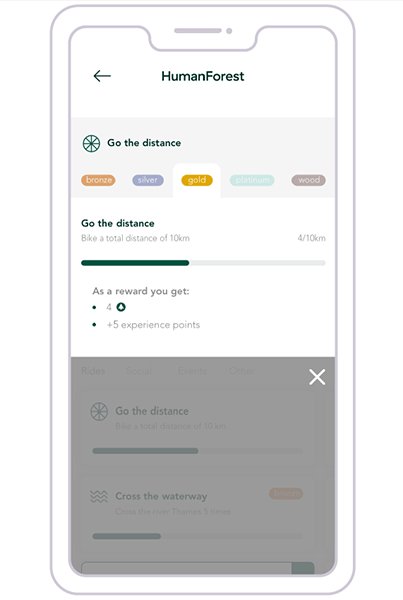
The HumanForest app demonstrates a gamified experience where users collect TreeCoins and track their positive environmental impact, making each ride more meaningful.
Read the HumanForest success story! Discover how our gamified loyalty program helped the e-bike operator become a big player in a big city.
How you can use StriveCloud to create a gamified loyalty program inside your mobility app
Are you facing similar loyalty challenges in growing your mobility business? Here’s how to launch your own gamified loyalty program inside your mobility app!
If you’re building your mobility service on Wunder Mobility we have great news for you! Thanks to our direct integration with Wunder Mobility, we can easily set up our software to integrate the new gamification features straight into your mobility app. Don’t worry if you’re not, everything is still possible!
This is our bulletproof 3-step implementation plan:
- Consultation & workshop. In a 3-hour workshop, we will identify the best solution for your challenges, as well as how to engage your specific target audience.
- Gamification design plan. Time to gamify! Once we know your needs, our experienced team can start designing a gamification plan. Importantly, this step clearly defines what data and features your gamified loyalty program will leverage to reward your customers.
- Set-up and implementation! After setting up our software, we will onboard & train your team on how to use it. That way, you can easily iterate on the experience and change your gamification features & loyalty schemes from a simple control panel linked to your app!
Michael Stewart @Human Forest - "PERSONALLY, I REALLY LIKE THE CONTROL PANEL OF STRIVECLOUD, AND I THINK IT IS EASY TO USE. I CAN INSTANTLY IMPLEMENT CHANGES WITHOUT HAVING TO WAIT 24 HOURS OR MORE TO DEPLOY"
How can you benefit from a gamified loyalty program? Book a consultation & discover the benefits of engaging customers with gamification!
FAQs
What trends will shape shared mobility in 2023?
In 2023, shared mobility will continue to grow. The global market is predicted to expand at a rate of nearly 17%, providing many new growth opportunities. However, the industry’s biggest names will continue to dominate, creating a challenging environment for mid-size firms.
What is gamification?
Gamification is the use of game-like elements such as badges, points, and leaderboards in non-game contexts. It’s often used to motivate people to complete certain tasks or reach goals that would otherwise feel boring or unimportant—for example, a gamified loyalty program.
Why the shared mobility model is perfect for gamification?
Shared mobility apps are the perfect fit for a gamified loyalty program. Here’s why! By their very nature, shared mobility apps create and run on vast amounts of data, such as duration, distance, and frequency. Gamification gets its power from leveraging this data!
Related Posts

How mobility operators can create growth with gamified loyalty programs
Yes, shared mobility is set to expand at a fast rate of nearly 17% in 2023. But big names still dominate the market! So how do mid-sized shared mobility operators break through with such tough competition? We'll let you in on a proven trade secret: gamified loyalty programs. Here's how it could benefit your mobility app!
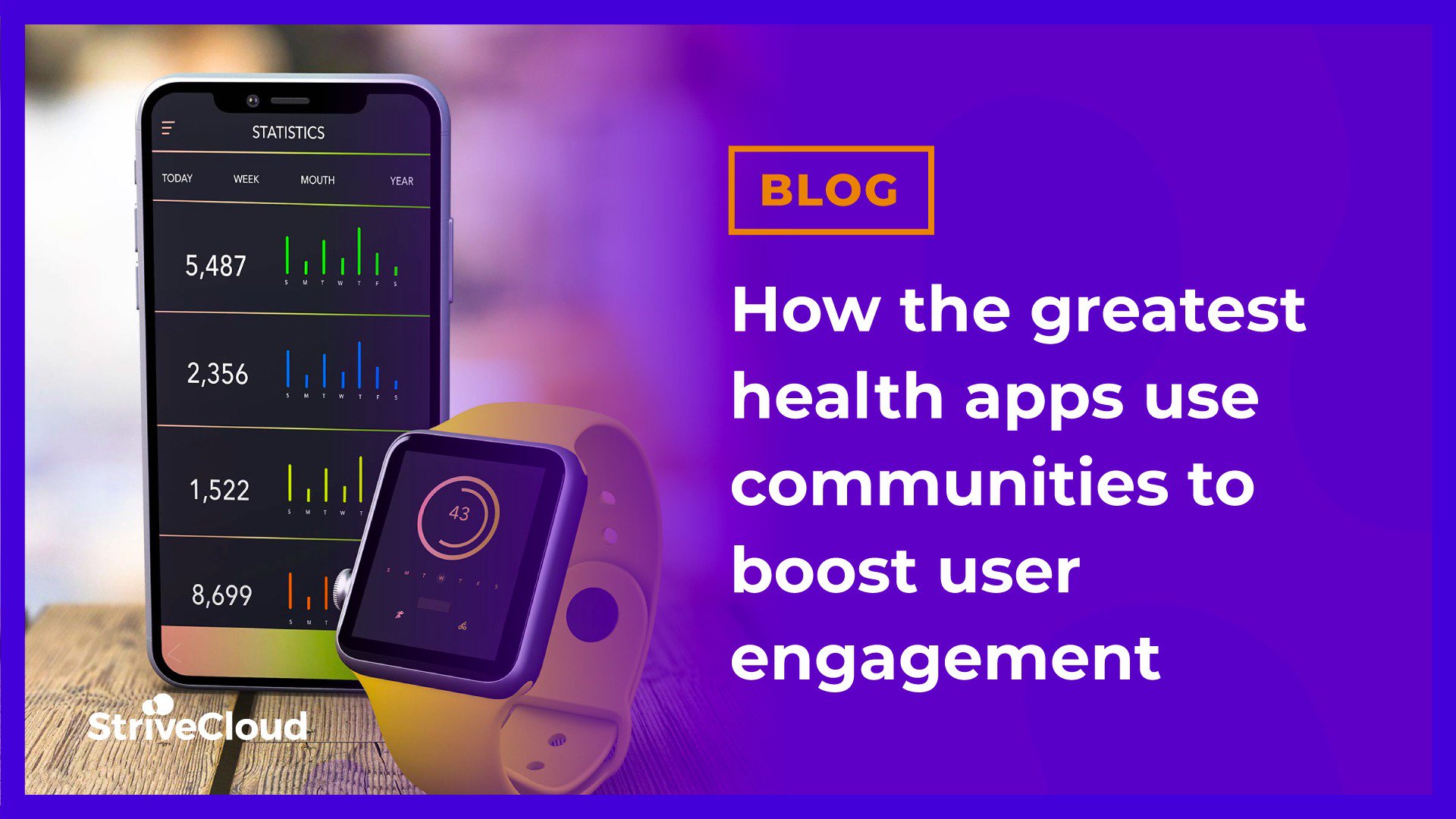
How the greatest health apps use communities to boost user engagement
It's no secret mhealth apps have the power to drastically impact how we approach health. With solutions for diabetes testing, elderly care or general health & fitness everyone can achieve their goals with a little digital help. Unfortunately, most mhealth apps lose the attention of their users in a matter of days. If they want to truly impact a user's health, they need to build a better and more engaging user experience. In this article, you'll discover the peer community secret behind some of the greatest mhealth apps. check it out!

